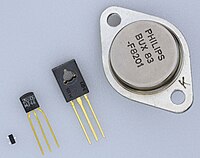
Photo from wikipedia
Abstract Effect of nitro group on thermal degradation process of polybenzoxazine was explored in this work through investigating p-nitrophenol-aniline-based benzoxazine (np-a) and its polymer (Pnp-a). The DSC and FTIR results… Click to show full abstract
Abstract Effect of nitro group on thermal degradation process of polybenzoxazine was explored in this work through investigating p-nitrophenol-aniline-based benzoxazine (np-a) and its polymer (Pnp-a). The DSC and FTIR results show that the polymerization of np-a could complete even after a process at 160 °C for 1 h. TGA results in N 2 and air atmosphere indicate that the char yield, thermal and thermo-oxidation stability of Pnp-a were better than those of phenol-aniline-based polybenzoxazine. And the similar DTG curves of Pnp-a in N 2 and air were observed, implying that the degradation mechanism of Pnp-a in N 2 and air was alike. These suggest that the essence of thermal degradation of Pnp-a in N 2 was oxidation degradation. Furthermore, TGA-FTIR results show that the obvious volatilization of CO 2 and H 2 O was detected during the almost whole thermal degradation process of Pnp-a. Py-GC-MS measurements and the structure evolution of Pnp-a during the thermal degradation process demonstrate that CO 2 mainly resulted from methylene on Mannich bridge being oxidized by hydroxyl radical. Besides, LOI test shows that the flame retardance of polybenzoxazine copolymer increased with the addition of Pnp-a.
Journal Title: Polymer Degradation and Stability
Year Published: 2017
Link to full text (if available)
Share on Social Media: Sign Up to like & get
recommendations!